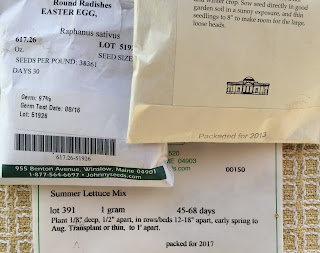Backyard gardeners think and talk about soil a lot, especially topsoil... but that is only scratching the surface so to speak. If you have bought a load of "topsoil" to start your garden, that soil is probably very different, and hopefully better, than what you have in your backyard. But do you really know what you got?
There is no definition of topsoil that spells out what it has to be. Topsoil can be whatever someone scoops up from the earth's surface someplace, labels and sells it as topsoil. It can be great for your vegetables, or it can be lacking in nutrients or its pH can be unsatisfactory. If you are going to order a truckload of topsoil, at least ask about its pH value. The supplier should be able to tell you. If the supplier does not know, then you know you need to think about getting a soil test.
The soil's pH is important because it affects how readily nutrients such as nitrogen, potassium, phosphorus and a few others can be used by your plants. If you remember any high school chemistry, pH is measured on a logarithmic scale between 1.0 and 14.0. Soil pH values in the range of between 6.2 - 7.2, basically a neutral range, i.e. neither acidic or alkaline, are good for growing most vegetables. But considering that it's still winter and you cannot yet dig in your garden, let's talk about the character of soil in general and little bit about Rensselaer County's soils.
The soil cross-section to the left shows its defining layers, called
horizons, starting with a thin first layer of detritus (called the
O horizon) and most easily recognizable in forests as "the floor," followed by topsoil (the
A horizon), then the subsoil layer (the
B horizon) and finally reaching bedrock (the
C and R horizons).
The
O horizon, when it is recognizable, can be measured at most in a couple of inches, usually much less. The topsoil layer, or
A horizon, is where the organic and mineralogical components mix along with air and water. It is also where most subsurface life exists,
e.g. earthworms, grubs, bacteria, and roots. The
A horizon frequently is between a few inches to about one feet in depth, but can be deeper. The underlying subsoil layer, the
B horizon, may typically vary between a few feet to hundreds of feet in depth; and finally the
C and R horizons, first consisting of broken fragments and then solid bedrock that simply goes a long way down.
The mineralogical characteristics of topsoil originate from bedrock, the
R horizon. Although the above cross section gives the impression that bedrock fragments gradually migrate upward over eons, the reality might be better pictured as fragments disintegrating from the weathering of bedrock outcroppings or volcanic flows (
think mountain peaks, plateaus, slopes etc.) with water and wind providing the common methods of soil redistribution to and accumulation in lower elevations.
Rensselaer County
For Rensselaer County, its soils came from glacial sources, tills, drumlins, outwashes etc., as the county emerged from the last Ice Age starting about 13,000 years ago. In the western third of the county this glacial sediment covered over much of the earlier topography with sand, gravel and clay creating outwash terraces that in some places reach depths of 200 plus feet. Not so in the county's central area, the Rensselaer Plateau, whose original surfaces were first closely scraped by glaciers and later left with relatively little sediment, but with many boulders, by the receding glaciers. In the county's eastern-most region that is drained by the Little Hoosic River and its tributaries, glacial sediment accumulated also in similar fashion to what happened on the western side of the county but the general slope of the land is more gradual. For gardeners interested in more information about county geography and soils, I recommend the 1988 U. S. Dept. of Agriculture's
Soil Survey of Rensselaer County Soil. It makes great reading if your just a little wonkish.
Now let's get back briefly to topsoil (the
A horizon) for a wrap-up. Remember that topsoil's organic material must accumulate over time before the soil can support much biodiversity. That initial accumulation may start with some bacteria or a few pioneering plants whose seeds might have been distributed by wind or perhaps birds; and after generations of these organisms, different species including animals can begin showing up. A commonly cited figure (
and maybe
optimistic for this region) is that an inch of topsoil requires 300 - 500 years to develop once an ecosystem is established. However, climate is the most important factor determining the rate of topsoil formation. A few centuries probably does work for warmer environments. For temperate climates like Rensselaer County's with its cold winters and elevation changes of almost 2,800 feet, an inch of topsoil might easily require 3,000 years or longer to develop.
So, whether you either are turning over your backyard's topsoil with a spade or buying topsoil by the bag and/or truckload, you are handling a natural resource that has taken a very long time to develop and is beyond any mere mortal's ability to replace.






